How to send email survey requests (with templates and examples)
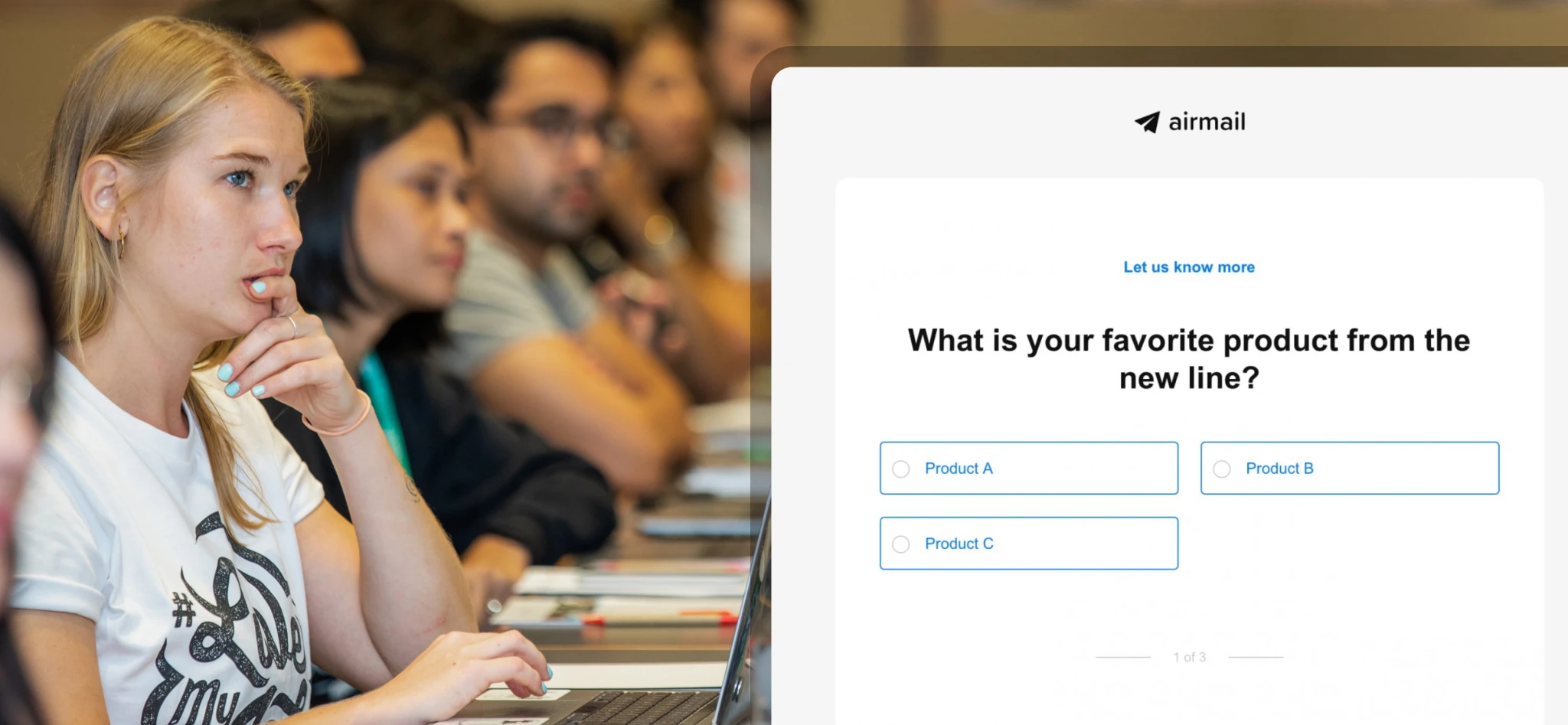 Sabina, Customer Support Shift Lead
Sabina, Customer Support Shift Lead
Ah, the email survey. Not just another marketing email, but a golden ticket to understanding your audience like never before.
Your subscriber list is a treasure trove of hidden wisdom, and a skillfully designed survey email is the key you need to unlock it.
Sending survey emails allows you to send questions to specific groups of respondents who are already invested in your business and therefore more likely to complete the survey and provide genuine responses.
With inboxes overflowing with generic content, we’re here to help you unpack these 7 actionable tips and best practices for survey emails that even the most click-weary subscribers can't ignore. Plus, we'll share some ready-to-use survey email templates to get you off to a flying start. 🚀
Benefits of sending a survey request email
The customers on your email list have opted in to interact with you on a regular basis. These subscribers are going to have valuable feedback that will benefit your business.
By asking and displaying the right survey questions in your embedded survey, you can get to know what your target audience thinks while increasing your subscriber engagement.
We looked at thousands of newsletters with embedded surveys to find out just how effective they can be for your engagement and discovered some pretty insightful data, along with a few extra benefits:
Increased engagement metrics: Embedding surveys directly in emails increased the click-to-open rate to an average of 31.7%. This means more people interact with the content.
Easy to complete: Embedded survey emails get 135% more overall clicks compared to external survey links. Since the survey is right in the email, it's easy for recipients to complete it without having to go to another website.
Quick to build: Creating an embedded survey in an email can be done in under 5 minutes, making it a very low-effort, high-impact email marketing strategy.
Real-time feedback: With embedded surveys, you can get immediate responses that are easily accessible and organized. This allows for quicker analysis and data-driven decision-making.
Cost-effective: Using an ESP like MailerLite that allows you to embed surveys directly into your newsletters saves you from needing to pay for expensive third-party applications.
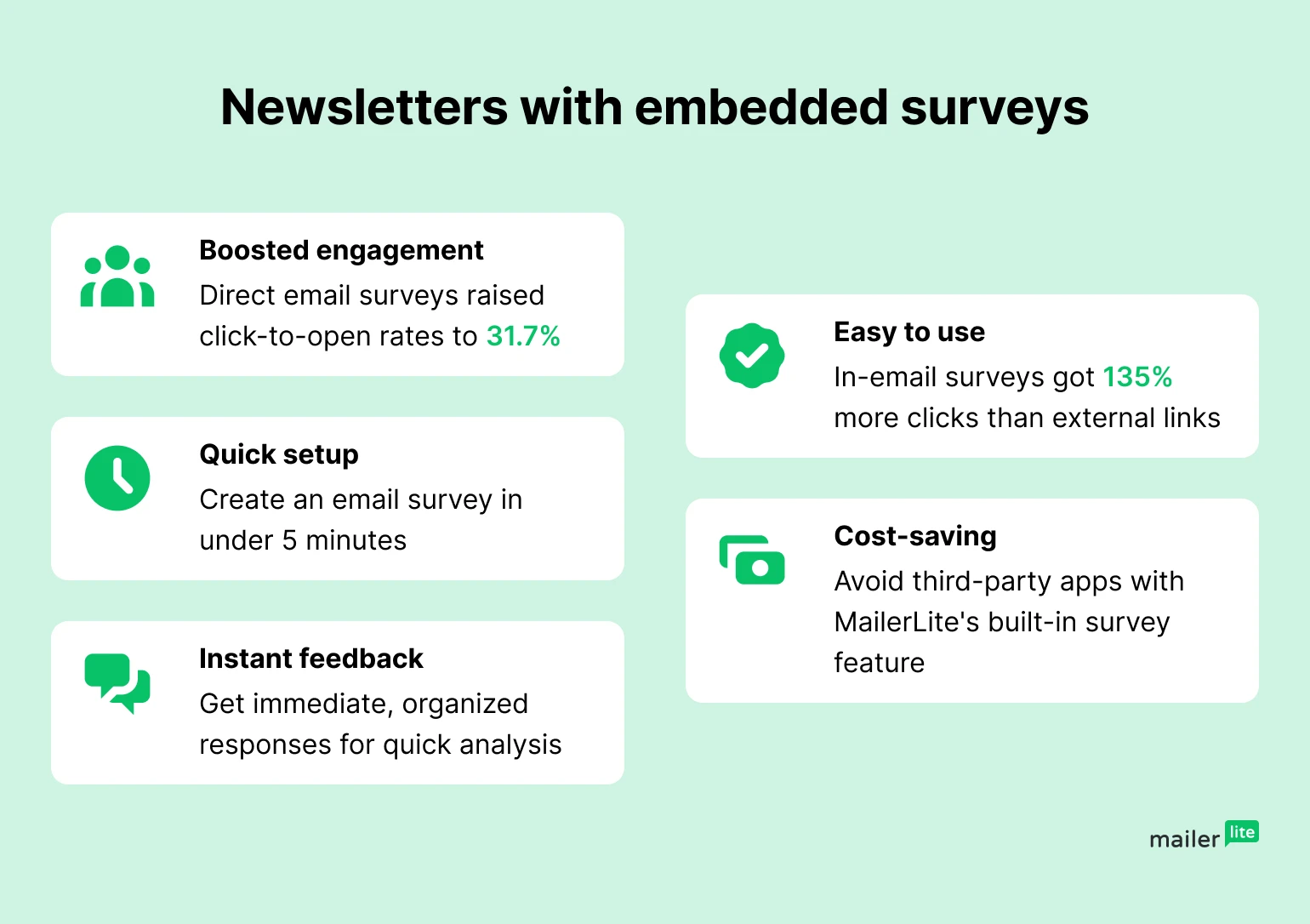
When done right, survey emails can be a powerful tool. Research conducted by PeoplePulse found that response rates can be as high as 85% when the target audience is motivated and the survey is well-executed. So let’s talk about how you can craft different types of surveys that will engage subscribers and deliver results.
Types of email surveys with copy templates you can use
There are several types of email surveys, each of which is designed for specific goals and contexts. Let’s take a look at some of the most popular. And remember—you can take these survey email templates and use them in your own surveys!
1. Post-purchase and delivery email survey
This type of email survey is designed to collect feedback from customers after they have completed a purchase and received it. The goal is to gain actionable insights into the customer’s experience throughout the purchase and delivery process so that businesses can improve their products, services, and customer experience.
Some components that you might include in a post-purchase and delivery survey include:
Purchase experience: Ease of purchase, smoothness of transaction, payment options
Delivery experience: Delivery time, service, packaging
Product satisfaction: Quality, expectations, usage, issues, customer support
General satisfaction: Feedback about overall experience, likelihood to recommend
Subject: We value your feedback—let us know what you think!
Preheader: Share your experience with [Company Name] and help us improve our products and services.
Hi {$name},
Thank you for your recent purchase from [Company Name]. We hope you’re enjoying your new [Product Name]!
Your satisfaction is our top priority and we would love to hear about your experience with us. We would really appreciate it if you could take a few moments to complete this short survey to let us know how we did.
Any feedback will help us to improve our products and services to better meet your needs.
Start survey
[Survey Questions]
1. How easy was it for you to find the product you were looking for on our website?
2. Were you satisfied with the payment options available?
3. How satisfied are you with the quality of the product you received?
4. Did the product meet your expectations as described on our website?
5. Was your order delivered on time?
6, How would you rate the packaging of your order?
7. How satisfied were you with the delivery service?
8. Have you encountered any issues while using the product?
9. How would you rate your experience with our customer support team (if applicable)?
10. Overall, how satisfied are you with your recent purchase and delivery experience?
11. On a scale of 1-10, how likely are you to recommend our company to a friend or colleague?
12. Do you have any additional comments or suggestions to help us improve?
[End survey]
Thank you for taking the time to share your feedback! We appreciate your input!
2. Market research survey email
A market research survey is used to collect data about a target audience to understand their demographics, preferences, behaviors, motivations, opinions, and attitudes toward products, services, brands, or market trends.
Businesses can use these insights to understand the needs of their ideal customer and make informed decisions about the strategies they implement to meet customer needs.
Components of a market research survey include:
Demographics: Age, gender, income, education, etc.
Behavioral insights: How customers use services or products, buying habits
Preferences: Opinions about products, features, brands, market trends
Satisfaction and loyalty: Satisfaction with products and service, loyalty to brand
Market trends: Emerging trends and shifts in customer behavior
Subject: Take part in our customer survey and help us improve!
Preheader: Shape the future of [Company Name]—it will only take a few minutes.
Hi {$name},
We're working on bringing some big improvements to [Company Name]—and it’s all for you, our valued customers!
To make [Company Name] the best that it can be, we need your help. We want to learn more about you so that we can better meet your needs.
We promise it will take just a few minutes to complete, and your answers will be kept completely anonymous.
Start survey
[Survey questions]
1. What is your age group?
2. What is your gender?
2. How often do you purchase products in the [Product Category]?
3. Where do you usually shop for [Product Category]?
4. What features are most important to you when purchasing [Product Category]?
5. Which brands do you prefer for [Product Category]?
6. How satisfied are you with our current product?
7. How likely are you to recommend our brand to a friend or colleague?
8. What new trends in [Industry] are you most excited about?
9. Do you have any additional comments or suggestions?
[End survey]
Thank you for sharing your valuable feedback! Your participation is very much appreciated.
3. NPS survey email
Net Promoter Score (NPS) survey emails measure loyalty and satisfaction with a company, product, or service.
This type of survey is usually very short and typically only contains one question asking the respondent to rate their level of satisfaction from 0-10. Based on their response, customers can be categorized as Promoters (9-10), Passives (7-8), or Detractors (0-6), and you may ask a follow-up question to gain further insights.
Subject: Let us know what you think with a single click
Preheader: Quick survey inside—we’d love your feedback!
Hi {$name},
We hope your recent experience with [Product/Brand/Service] has met your expectations. Your feedback is extremely important to us, and we would love to hear how we’re doing!
Would you mind taking a moment to answer this quick question?
On a scale of 0 to 10, how likely are you to recommend [Product/Brand/Service] to a friend or colleague?
For Promoters (9-10):
We’re so happy to hear that! Could you spare a few words about what you like the most? Or any suggestions you have?
For Passives (7-8):
Thank you for your response! Could you spare a few words about what you enjoy and what you think could be improved?
For Demoters (0-6):
Thank you for your response, we appreciate your feedback. Could you spare a few words about what you think could be improved?
[End survey]
Thank you for taking part in our survey. Your feedback is extremely valuable, and we look forward to serving you better.
4. CSAT survey email
CSAT stands for Customer Satisfaction Score and is another tool used by businesses to measure satisfaction in regard to their products, services, or brand. It’s similar to an NPS but instead of focusing on customer loyalty, CSAT surveys measure satisfaction at various points in the customer journey.
It typically consists of a single core question that asks customers to rate their satisfaction on a scale of 1-5 or 1-10, which may be followed up with additional questions to gain more detailed feedback.
Subject: Let us know how we did in this short survey
Preheader: It’ll only take a moment and will help us improve our service!
Hi {$name},
Thank you for choosing [Company Name]. We hope you’re satisfied with your recent experience! To help us serve you better, we would really appreciate your feedback—it’s just a few short questions and shouldn’t take more than a couple of minutes.
Start survey
[Survey questions]
1. How satisfied are you with your recent purchase from [Company Name]?
2. What did you like most about your experience?
3. What can we improve?
4. Do you have any other comments or suggestions?
[End survey]
Thank you for your valuable feedback! It will help us to improve our product and services to better suit your needs.
5. Post-event survey email
This type of email survey allows businesses to follow up with attendees after an event to gather feedback about their experiences. These insights then allow for the evaluation of the event’s success in various aspects, including organization, venue, itinerary, content, speakers, and more. Event organizers can then use this feedback to improve future events and evaluate their effectiveness.
Here are some key topics to include in a post-event survey email:
Venue: Location, facilities, space
Content: Was the content enjoyable, informative, insightful, worth the time/cost
Organization: Event check-in, pre-event communication, instructions/directions, seating
Itinerary: Was the itinerary well thought out, easy to follow, accurate
Speakers/Featured participants: Were the featured participants or speakers suited to the event/satisfactory
Overall experience: Was the event enjoyable, insightful, satisfactory
Subject: How did you find [Event Name]?
Preheader: Share your feedback to help us improve our future events.
Hi {$name},
Thank you for joining us at [Event Name]! We hope you had a great time and found the event valuable.
To help us improve and make our future events even better, we would love to hear your feedback. Please take a few minutes to fill out our post-event survey, it’s quick and painless—we promise!
Start survey
[Survey questions]
1. How would you rate your overall experience at [Event Name]?
2. How satisfied were you with the content presented at the event?
3. Which sessions did you find the most valuable?
4. How would you rate the quality of the speakers and presenters?
5. Do you have any comments or suggestions about the speakers and presenters?
6. How would you rate the organization of the event (e.g. registration, schedule, information, check-in)?
7. How satisfied were you with the venue and facilities (e.g. location, space, seating, catering, restrooms)?
8. How would you rate the networking opportunities provided at the event?
9. How likely are you to attend our future events?
10. Do you have any additional comments or suggestions?
[End survey]
Thank you for taking the time to submit your feedback. We look forward to seeing you at our next event!
6. Onboarding feedback email survey
When you’ve taken someone through an onboarding process, whether employees, customers, or users, you can send an onboarding feedback email afterward to gather feedback about their experience. This allows businesses to understand what went well and what can be improved so that they can develop their onboarding strategy and boost customer, user or employee satisfaction.
Some of the aspects (depending on the type of onboarding) that onboarding feedback emails cover include:
Ease of use
Clarity of information and instructions
Ability to navigate systems and find necessary tools/features/elements
Quality and availability of support
Available resources
Overall satisfaction
Subject: Share your experience with our onboarding process
Preheader: Help us make our onboarding better for other users/customers/employees
Hi {$name},
Thanks for joining us at [Company Name]! We hope you’ve had a smooth start.
As we strive to make our onboarding process as seamless as possible, feedback from customers/users/employees like you is extremely important.
We would really appreciate it if you could take a few minutes to complete our onboarding feedback survey to tell us about your experience. It won’t take long—promise!
Start survey
[Survey questions]
1. How would you rate your overall onboarding experience?
2. How easy was it to understand and follow the onboarding steps?
3. Do you feel that the information provided during the onboarding was clear and helpful?
4. How satisfied are you with the support and resources made available during the onboarding?
5. What could we do to improve our onboarding process?
6. Do you have any other additional comments or suggestions?
[End of survey]
Thank you for your valuable feedback! If you have any further questions or need assistance, you can always reach out to our support team.
Bonus: Pre-built survey email templates
In a hurry? Use one of our pre-designed survey email templates to build your next survey email fast! Simply create a new campaign, navigate to the template gallery and use the dropdown menu to select “Survey” to find our collection of survey templates.
Awesome email survey examples
The surveys you create will be unique and specific to your audience. Here are 5 nicely designed survey email invitation emails to inspire your own email campaigns.
✈️ Post-travel survey
Travel insurance firm World Nomads sends this survey email to customers the day after their insurance runs out. The timing means customers can give their opinion on the service while it is fresh in their minds. The email also includes offers for customers to extend their insurance, which could lead to repeat buys.
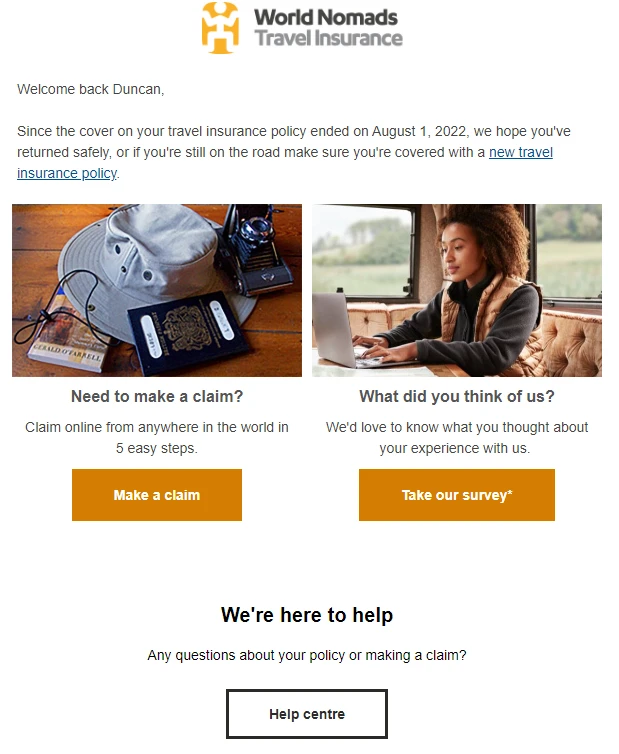
📢 Feature feedback survey
This survey email example from Moz is good because it asks for feedback on two specific product features. Anyone who uses these tools and has an opinion about them can complete the survey to share their thoughts. The chance to win an Amazon gift card increases the chances that people will participate.

📧 In-content CSAT survey email
EasyJet makes it super easy to start this CSAT survey by including the survey in the email content. Clicking the link leads customers to a longer survey that allows them to provide more detailed feedback. The email is personalized with the customer's name, booking number, and flight details.
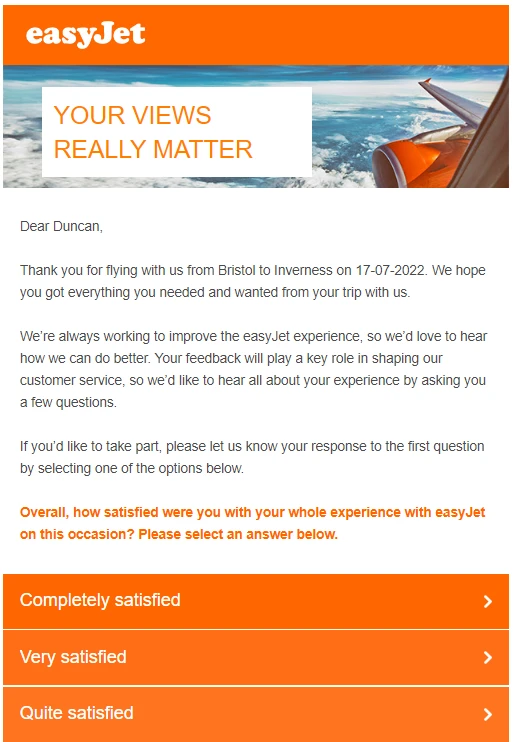
💻 Product changes feedback survey email
Making changes to a product is never easy, especially one as loved as KFC. The company created this email to gather feedback on product changes to see if the company is moving in the right direction. The copy and design of this email is very on-brand and will appeal to KFC fans.
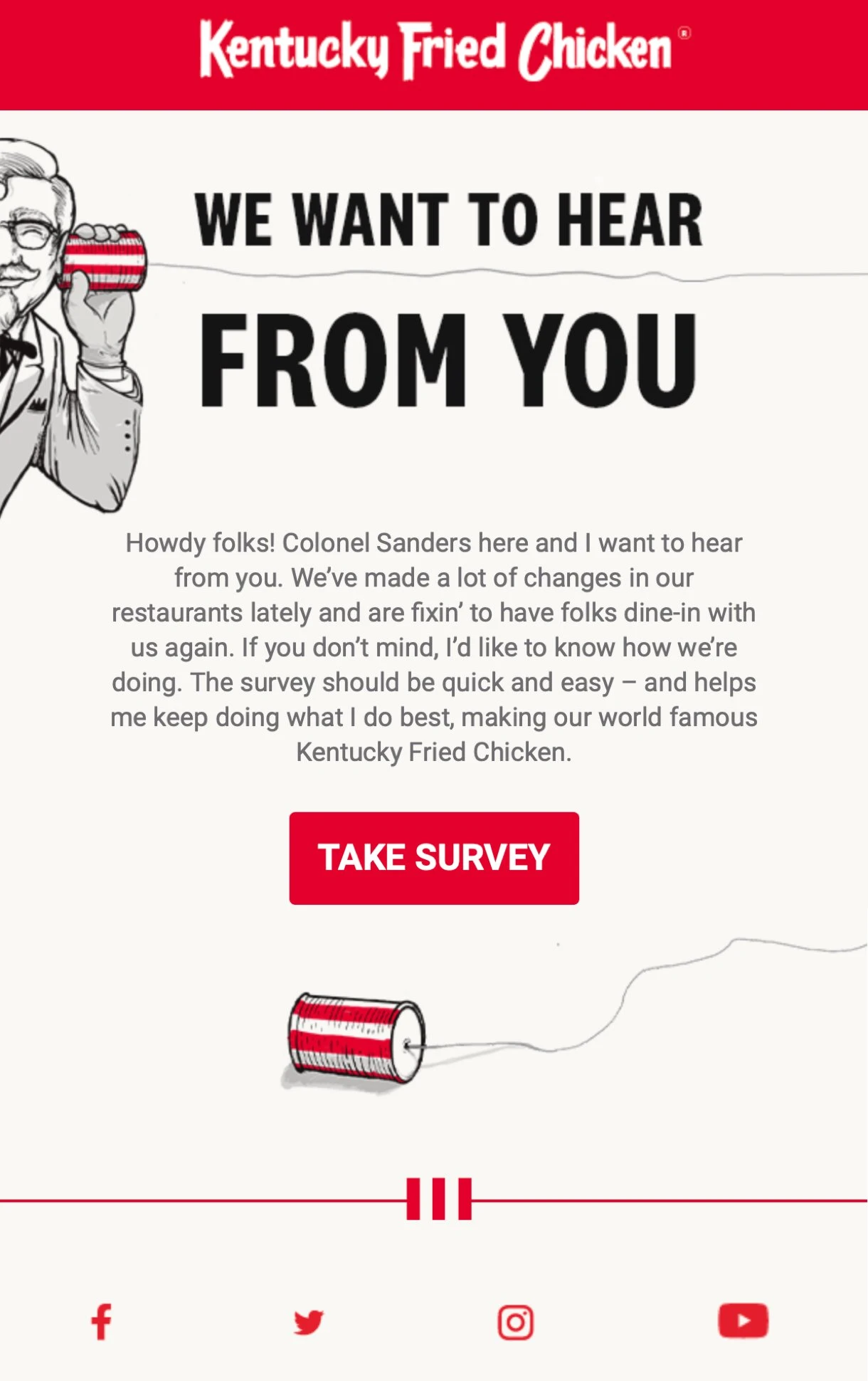
🕜 Survey reminder email
You can’t get 100% of your subscribers to complete your survey, but you can catch a few more by sending a simple survey reminder email. Take a look at this example from Anthropologie. They opted for a gentle, empathetic approach in their survey reminder email.
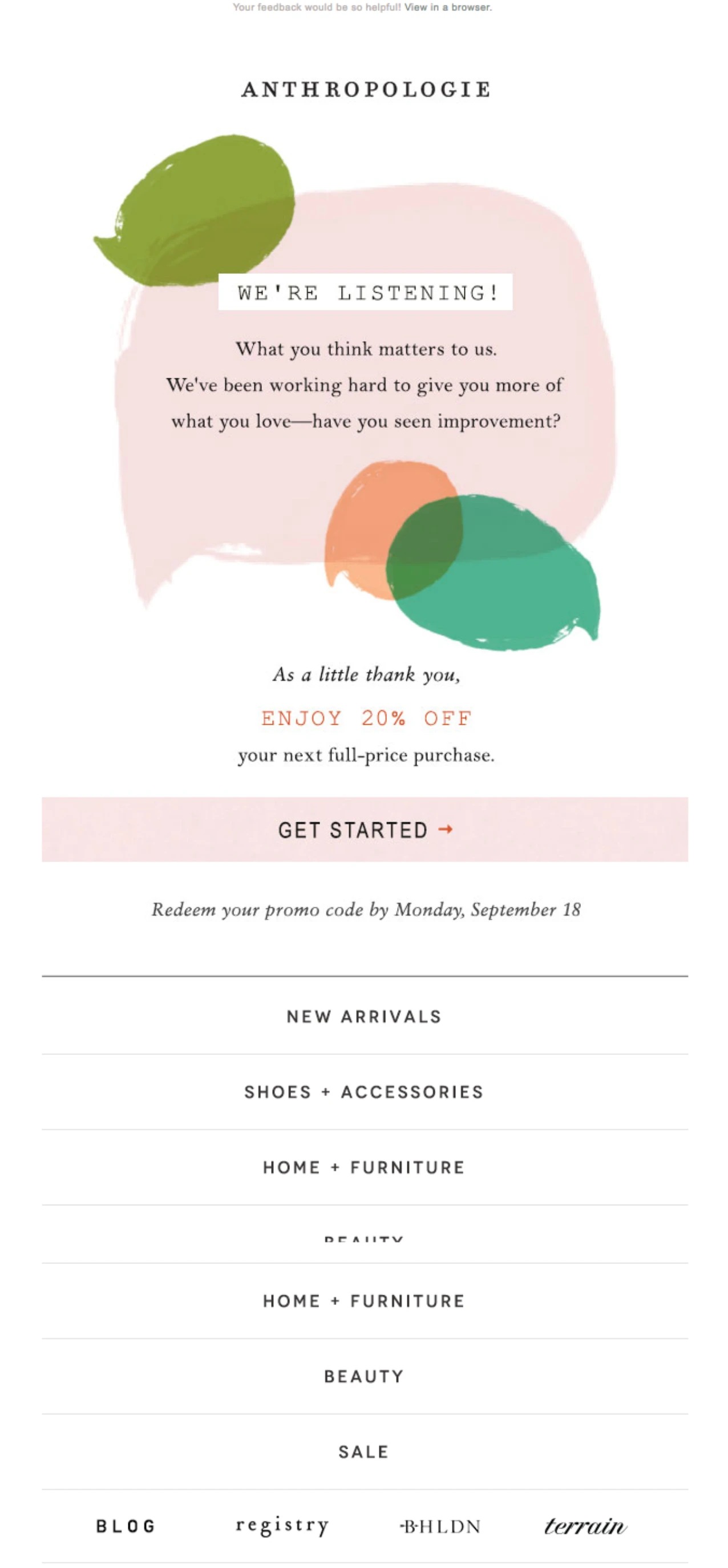
How to send email surveys with MailerLite
MailerLite’s pre-built survey block makes it oh-so-easy to add user-friendly questionnaires that will make your subscribers want to complete the survey every time. And with 8 survey question types to choose from—including NPS, satisfaction score, and open questions—you can effortlessly create surveys for every type of feedback collection.
Check out how simple it is to create your own email surveys in the video below.
Looking for detailed instructions on how to create a survey email? Our guide on how to embed a survey in a campaign will help!
7 tips and best practices for engaging survey emails
Survey invitation emails can go in many different directions. Follow these 7 best practices to stay on track and create effective messages. We’ve also included plenty of examples to get your creative juices flowing.
1. Narrow down what you want to learn
The hardest thing to do when putting your first survey together is to keep it focused on one thing. You have so many questions to ask, but the reality is that your respondents are only willing to give you a tiny bit of their time.
People are busy. Respect their time and they’ll be more willing to work with you and complete the surveys you send them.
Instead of listing a bunch of questions, identify different categories and create separate surveys for each one. For example, if you are conducting a customer satisfaction survey, you don’t need to ask detailed questions about your products. Save those questions for a product feedback survey.
Insurify adeptly creates an entire email around one question. By keeping it simple with a short survey, they can jazz it up with colors and graphics and drive engagement.
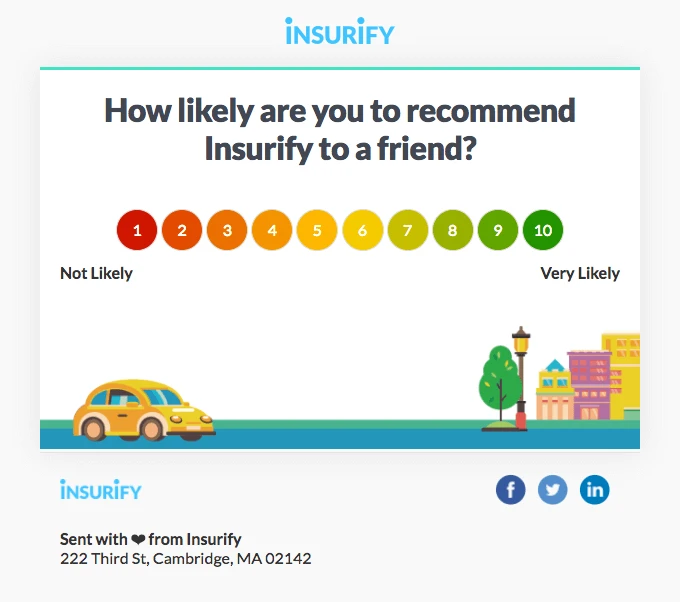
When you narrow down the scope of your survey, you’ll be able to write a survey request email that is single-minded and reassures your subscribers that you aren’t asking for too much of their time.
We've found that the best way to design your email and embed the survey is by focusing the attention on the survey. You can get higher response rates if you make sure the survey is the most important thing in the email—without having other distracting CTA buttons and links.
2. Target segments for the best survey results
The advantage of using email marketing for your surveys is that you can segment your respondents into smaller groups for optimal targeting.
If you want quality survey responses, you should send your survey emails to the people on your list who are most likely to respond to your questions.
By breaking up your audience into smaller groups, you can:
Get very specific about the kinds of questions you ask, which in turn provides better survey data to make decisions.
Personalize your emails to improve open rates, click rates and survey response rates. More people will complete the survey if it is targeted to their interests.
Avoid blasting your entire list with surveys that will annoy people who aren’t involved.
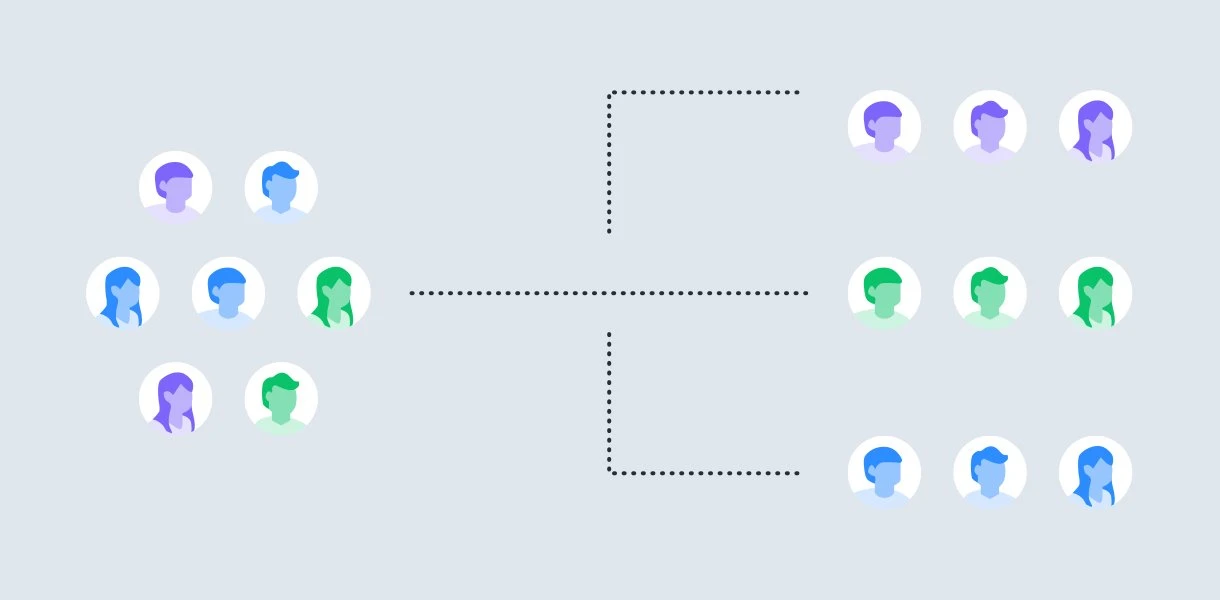
How you segment your list depends on what you want to learn from your surveys.
For example, if you want to know why subscribers are buying certain products, check their purchasing history. If you're curious about the type of content they'd be interested in, add links to specific blogs and set up an automation for when that link is triggered. The same goes for finding out what services customers would be interested in.
If you're not sure where to start, you can also start segmenting subscribers in your welcome email.
Sleeknote sends an automated email survey to new blog subscribers to determine who their readers are.
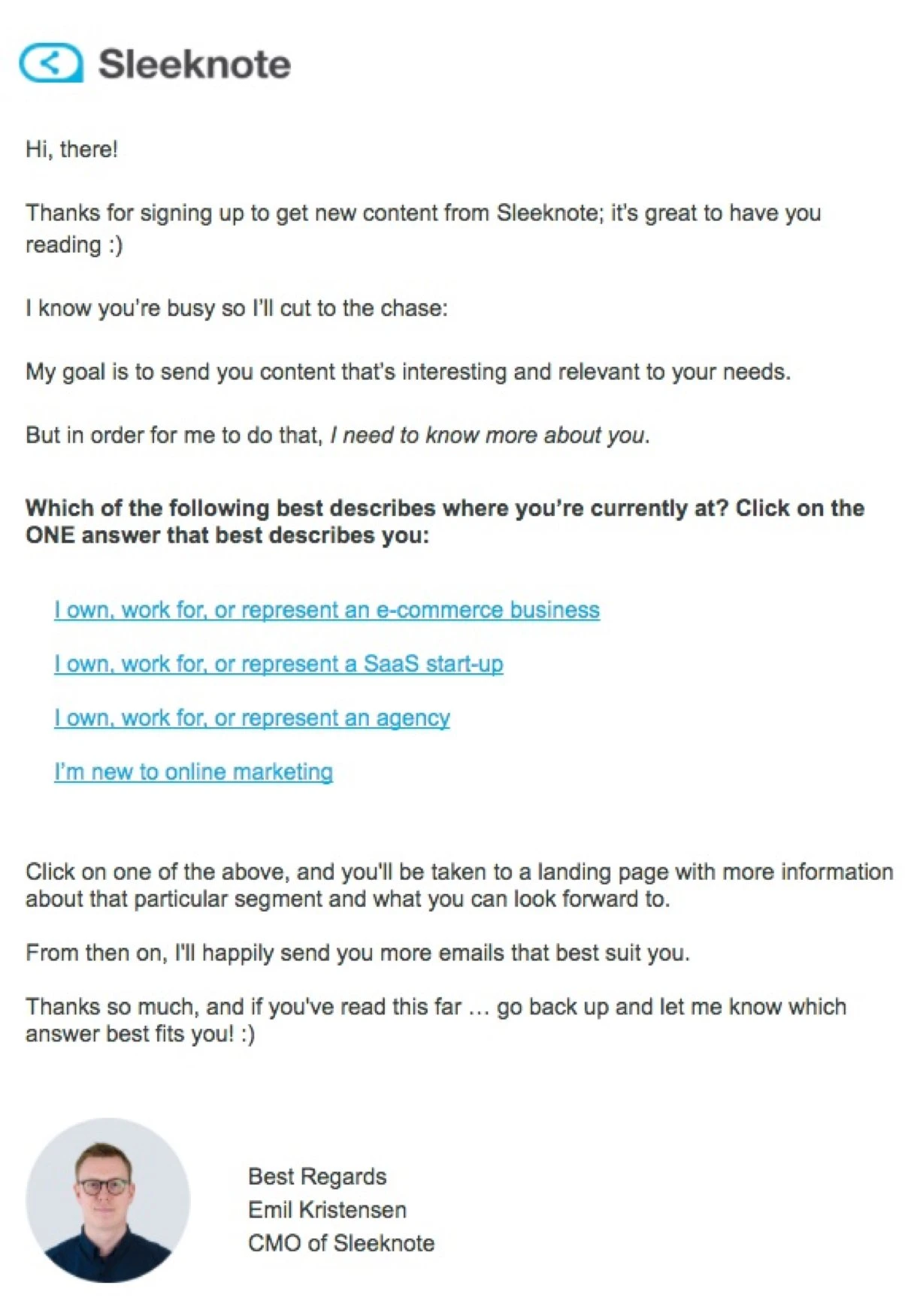
3. Use embedded surveys when possible
Traditionally, email surveys invite people to take part and then provide a survey link or button to send them to the survey landing page. The problem is that you need to rely on a click-through before the subscriber gets to see the survey.
What if you conducted the survey directly within the newsletter?
Embedded survey blocks give you the ability to start the survey directly from the newsletter. The embedded survey launches in the browser so subscribers can complete all the survey questions in one seamless step.
To find out if an embedded survey was more effective, we ran an experiment.
We created two emails:
Email A allowed users to answer the survey in the newsletter itself.
Email B had a CTA button that took readers to a survey page.
Email A
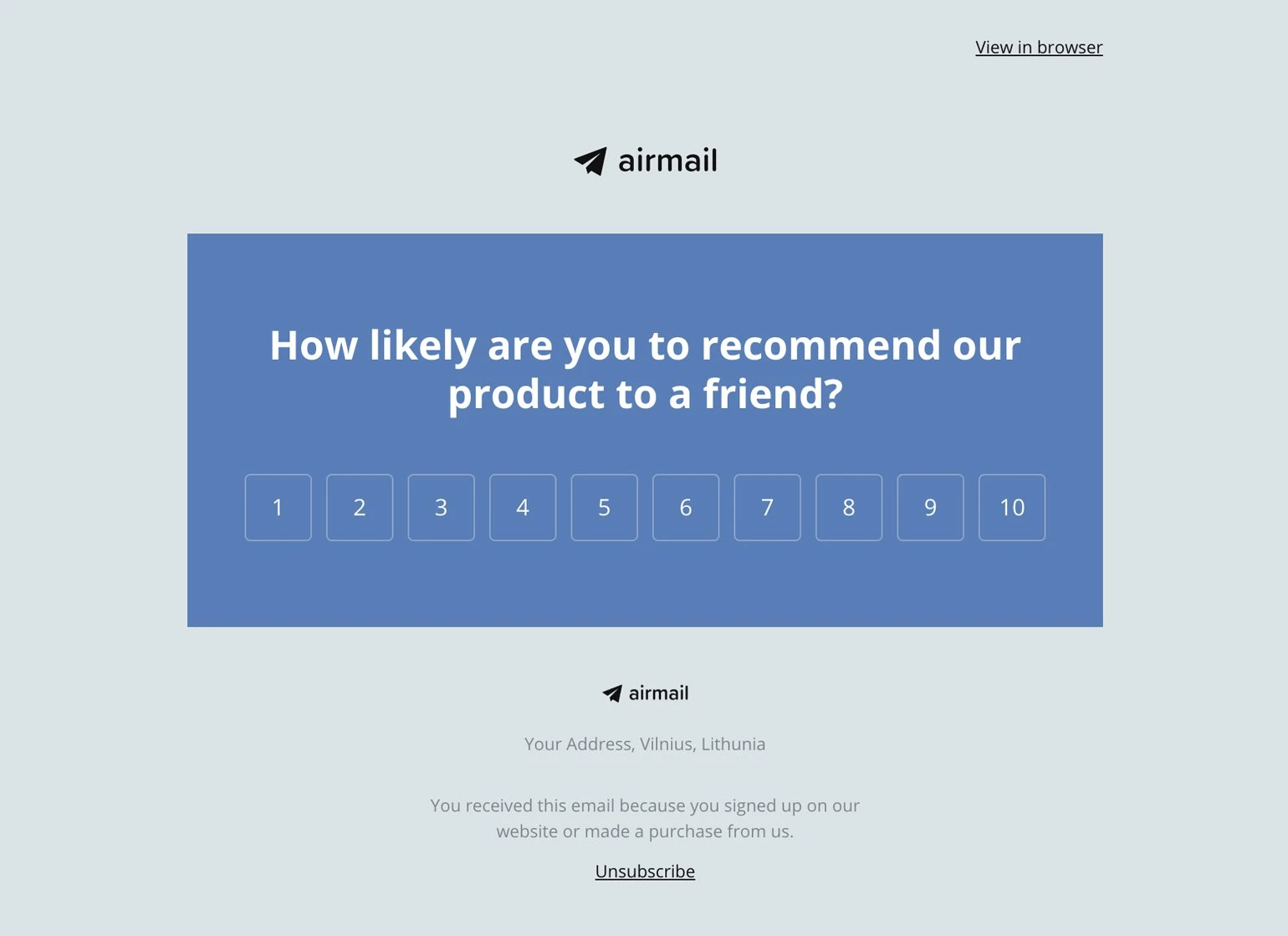
Email B
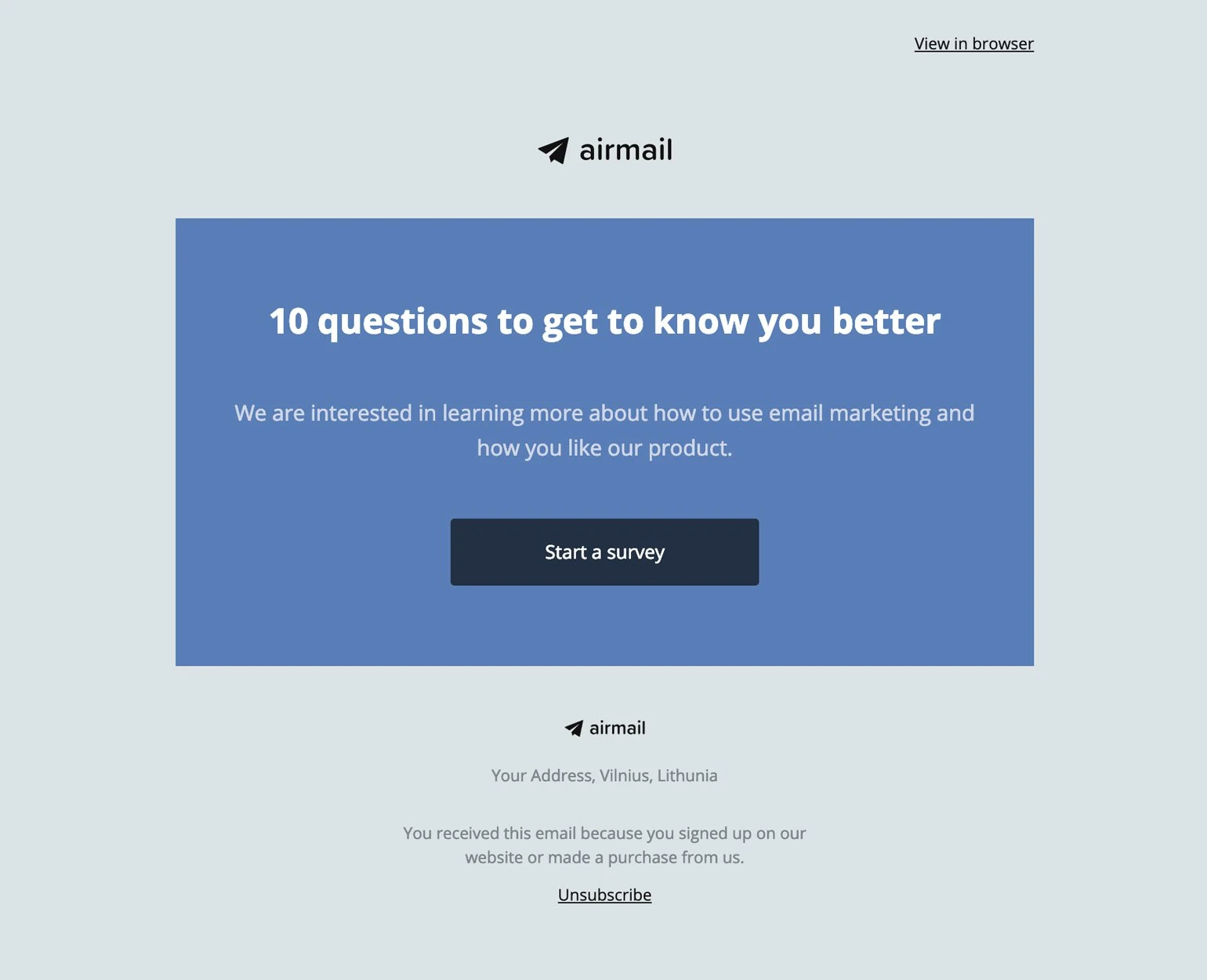
The results? Email A won. By a lot. It got 135% more clicks than Email B.
It was based on this insight, that we decided to build the survey email block that enables you to conduct different types of surveys directly from your email.
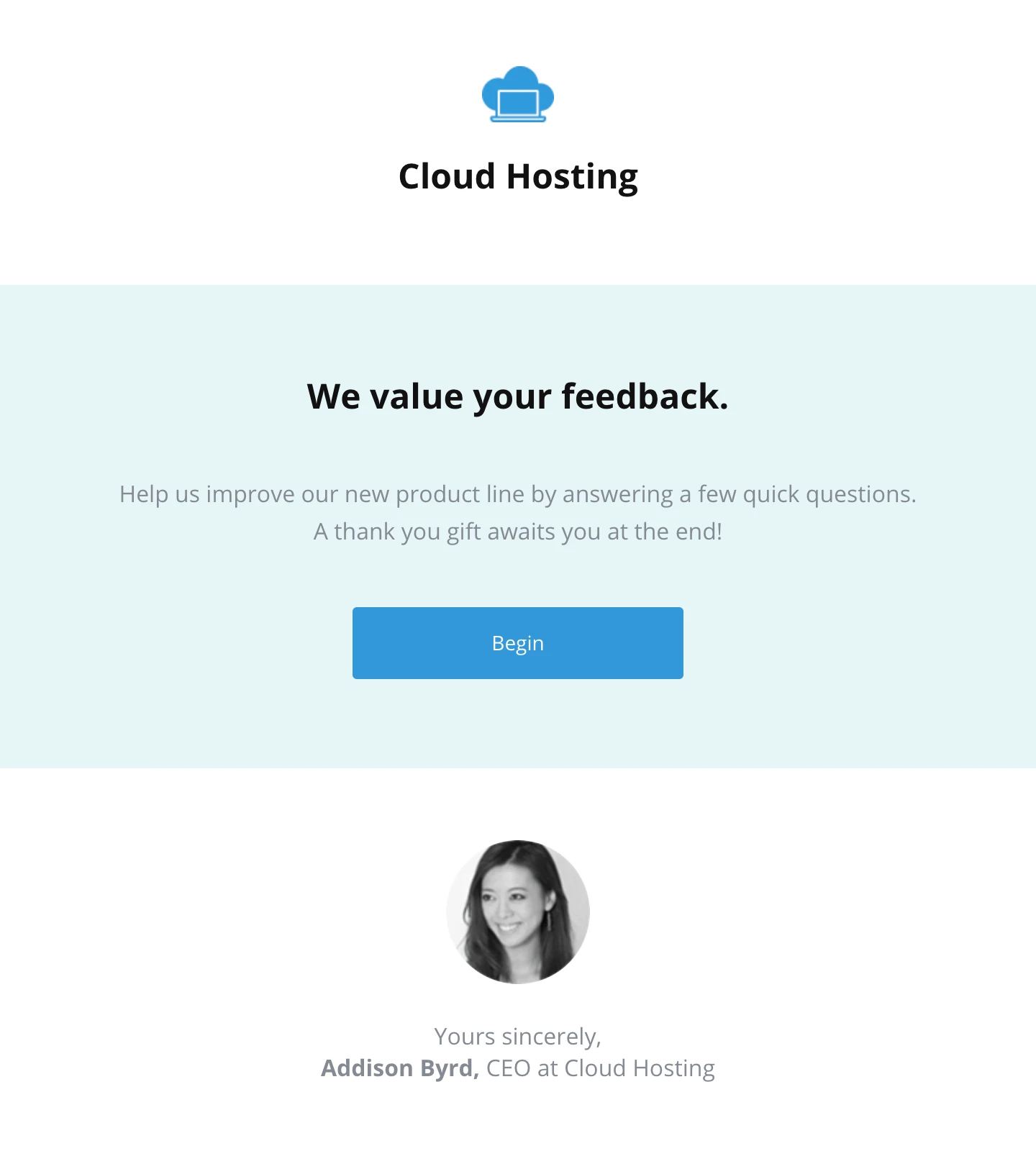
4. Write a clear and compelling survey invitation email
Asking someone to take a quick survey is like asking a friend for a favor. Except your subscribers are not your friends, so you need to go above and beyond to let them know how important their participation is to you.
Here are 4 guiding principles to keep in mind when writing your invitation. We've also included examples to highlight each point.
1. Show how the survey benefits the reader
You need to show how the survey benefits the recipient. This could be through a gift, entry into a prize draw, or simply the chance to improve the product.
Shopify makes this survey all about the reader by explaining how feedback helps the product improve. The company sweetens the deal by giving each participant a chance to win an $800 Apple voucher.
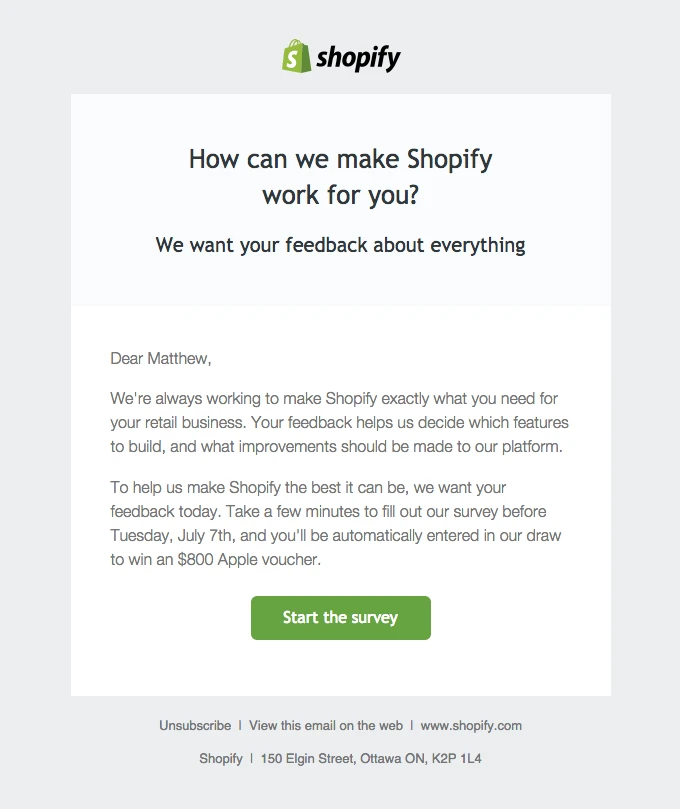
2. Clarify the survey's purpose
Clarifying the survey’s purpose ensures recipients know why they should participate and the types of answers to provide.
This email from Cigna explains how feedback allows the company to provide better service to the recipient and their family. Cigna also encourages responses by making the email simple, empathetic and personal.
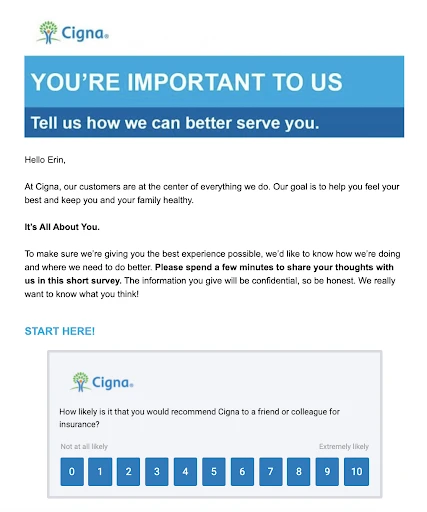
3. Make the survey participant feel important
Explain why you chose the person to complete the survey. Also, consider personalizing the email with elements like the recipient’s name to make them feel special.
Slack treats the subscriber like a VIP by calling out how the reader is just one of the few to get the survey. They also let subscribers know how much time they need to complete the survey—setting reasonable expectations for respondents.

4. Show the survey won't take long
No one wants to spend a long time on a survey. Letting recipients know how little time it takes to complete your survey can encourage participation.
This email survey example from Headspace highlights the simplicity and shortness of their survey email invitation. They use a clever headline acknowledging a common truth (surveys can be boring) and reassure people that this brief and engaging Headspace survey is worth their while.
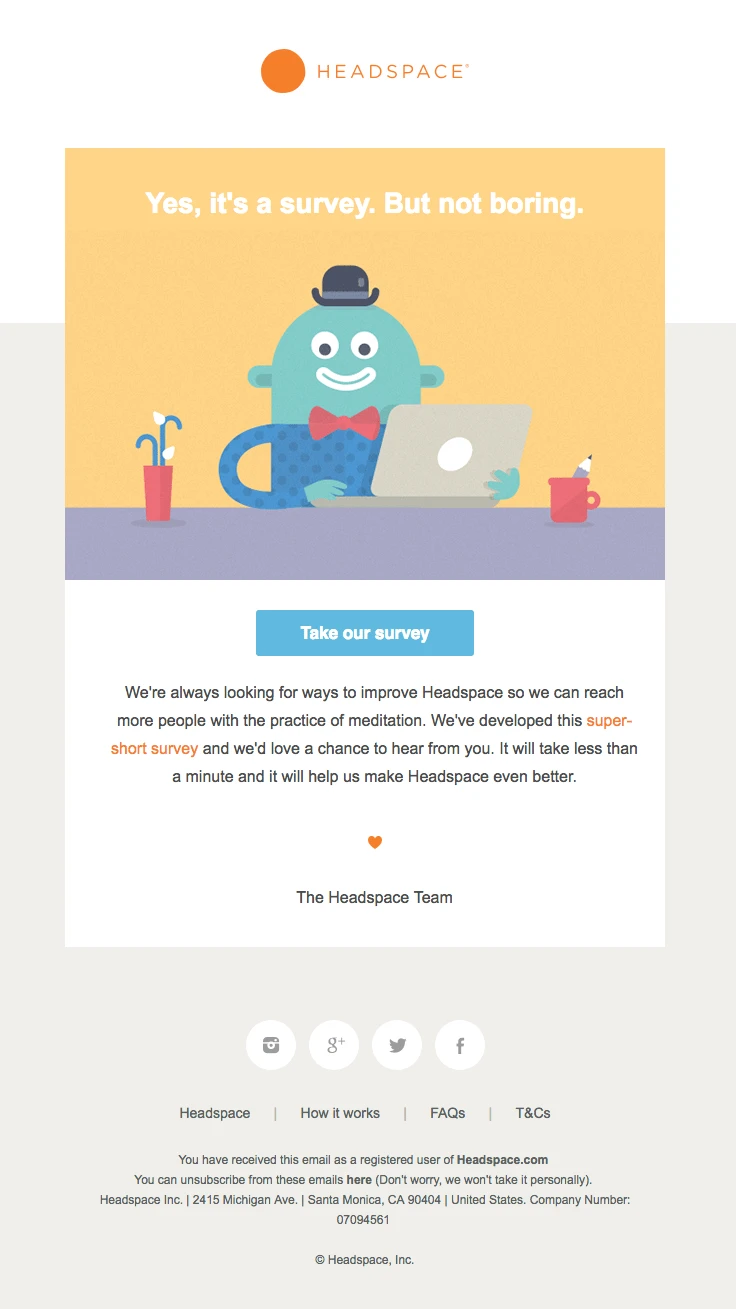
5. Make your survey email subject lines special
You worked super hard to create the survey and the email invitation. Don’t forget to seal the deal with a great survey invitation email subject line.
Subject lines are often the reason emails get opened. If you put something generic like “Customer Feedback Survey”, you are doomed. Show your recipients the importance of the survey by leading with a subject line that makes it hard not to open the email.
These subject line best practices still apply to email surveys. Below we'll go into some more survey invite email subject lines and best practices.
Add a name or something personal that will grab their attention.
Examples:
We need your feedback, [Name]! Help us serve you better
[First name], what do you think about your new [product]?
Megan, May I ask for your insight?
Hi Megan, have you got 3 minutes?
A little help, Megan?
We'd really love your insights!
You need to clearly communicate something that the reader cares about.
Examples:
You made our Top 100 customer list. We want to know what you think
Thanks for shopping with us! Here’s a link to share your feedback
Tell Us About Your Future Travel!
We need you — help us improve our emails
Megan, Help Us Decide Where to Go in 2022!
People like answering questions. Questions draw the reader into the conversation as a participant.
Examples:
Want to help us offer more services you love?
Can you answer 3 questions that will help change our company?
Got a few minutes to help?
How can Man Repeller improve?
Got a sec? Share some feedback
You increase your chances for a response when there is something worthwhile in it for the subscribers.
Examples:
Let us know how you feel and we’ll send you an Amazon gift card
Get 50% off for telling us what you think
Help Us, Help You (Chance to Win a $100 Gift Card!)
Let's Make Lovebox Better - Survey Competition
Reminder: Win a $50 Amazon gift card when you share your thoughts!
Share Your Insight - $25 Amazon Gift Card
6. Use survey rules to create new subscriber segments
When you send a survey email to subscribers, you’re not just learning about your business from the customer’s perspective—you’re also learning about your subscribers. It’s an amazing opportunity to segment subscribers based on their preferences so you can further personalize your email marketing.
For example, if you’re a digital marketing agency, you might send out a survey asking subscribers what their marketing budgets are for the coming year. Then you’ll be able to send each segment specific marketing recommendations based on realistic budgets. By adding rules to your survey questions that segment subscribers based on their answers, your email content will be more relevant and valuable to each group.
You can segment subscribers based on their survey answers.
There are multiple segmentation options when it comes to survey rules, including:
Moving subscribers from one group to another
Copying subscribers to a specific group
Updating a specific field with a custom value
Updating a specific field with the subscriber's answer
In this sample survey invitation email, a bookseller asks subscribers to select their favorite genres. The bookseller applied rules to the survey so that subscribers who answer are added to groups that correspond with their selected genres.
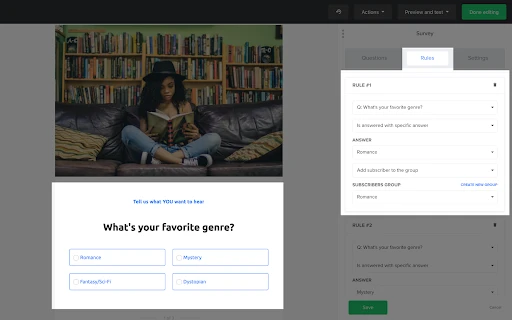
7. Use survey answers to inform your follow-up message
Sending your survey invitation email and getting feedback is just the beginning. Beyond using the survey answers to improve your business, you can also use the feedback to strengthen your relationship with subscribers.
For example, if you send a survey to gauge customer satisfaction, you can set up email automation to send people follow-up messages to address their current level of happiness.
At MailerLite, we tried this with our NPS email survey, where we gathered feedback and then used customer segmentation to collect more public reviews and points of improvement.
An alternative option is to include these follow-up messages within the survey. You can show different survey-completion messages depending on the answer given within the survey.
For example, in the Mailercheck NPS survey, we ask anyone who gives a positive answer to provide a review as soon as they finish the survey.
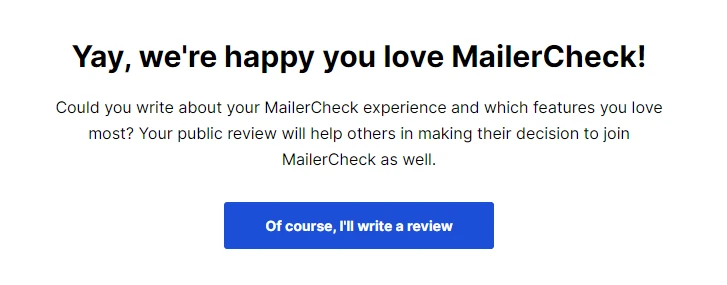
Likewise, we ask people who give a negative or neutral review how we can improve. This allows people to share their opinions straight after providing a negative score, which increases the chances of a follow-up.
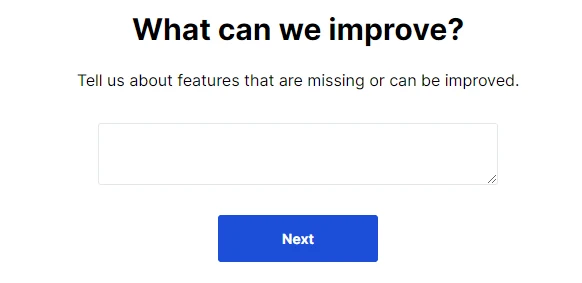
It’s easy to create a survey with multiple completion pages that change depending on the customer’s answer within MailerLite.
Using the dynamic survey rules feature, you can send customers to different slides depending on their previous responses. Check out the gif below to see this in action.

You can create these surveys and embed them in your email so customers don’t have to leave their email clients. Or you can use our page builder to create a survey on an external landing page and then link to this page from within the email.
Don’t pass up a golden opportunity to improve
Embedded email surveys allow you to dig for customer feedback that will improve your business. More responses mean more opportunities to learn and evolve.
Just remember to:
Keep it simple
Respect your subscriber’s time
Make it easy
And be grateful
What kind of questions do you ask your subscribers using embedded surveys? Let us know in the comments below!
Editor's note: This post was originally published in August 2021, but has been updated with new tips, email survey examples, and survey email templates.
